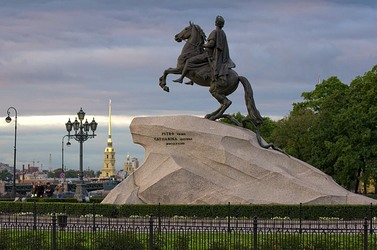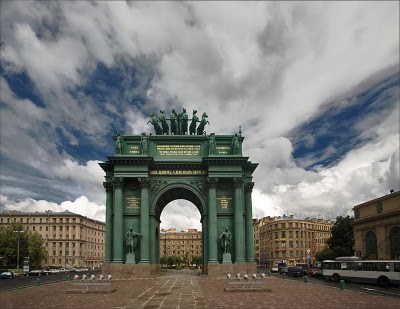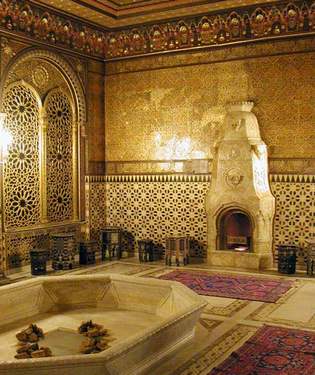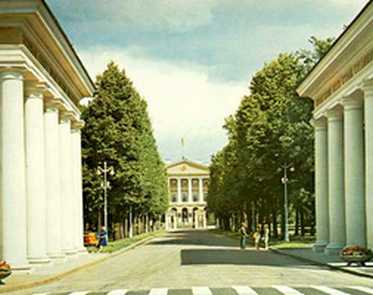|
PALACES AND MONUMENTS
The Peter and Paul Fortress is the original citadel of Saint-Petersburg, Russia, founded by Peter the Great in 1703 and built to Domenico Trezzini's designs from 1706-1740.
The fortress was established by Peter the Great on May 16, 1703 on small Hare Island by the north bank of the Neva River, the last upstream island of the Neva delta. Built at the height of the Northern War in order to protect the projected capital from a feared Swedish counterattack, the fort never fulfilled its martial purpose. The citadel was completed with six bastions in earth and timber within a year, and it was rebuilt in stone from 1706-1740.
The fortress contains several notable buildings clustered around the Peter and Paul Cathedral (1712-1733), which has a 123.2 m (404 ft) bell-tower (the tallest in the downtown) and a gilded angel-topped cupola.
The newer Grand Ducal Mausoleum (built in the Neo-Baroque style under Leon Benois's supervision in 1896-1908) is connected to the cathedral by a corridor. It was constructed in order to remove the remains of some of the non-reigning Romanovs from the cathedral where there was scarcely any room for new burials. The mausoleum was expected to hold up to sixty tombs, but by the time of the Russian Revolution there were only thirteen.
Other structures inside the fortress include the still functioning mint building (constructed to Antonio Porta's designs under Emperor Paul), the Trubetskoy and Alekseyevsky bastions with their grim prison cells, and the city museum. According to a centuries-old tradition, a cannon is fired each noon from the Naryshkin Bastion. Annual celebrations of the city day (May 27) are normally centered on the island where the city was born.
The sandy beaches underneath the fortress walls are among the most popular in Saint-Petersburg. In summer, the beach is often overcrowded, especially when a major sand festival takes place on the shore.
Bronze Horseman
The equestrian statue of Peter the Great is situated in the Senate Square (formerly the Decembrists Square), in Saint-Petersburg. Catherine the Great, a German princess who married into the Romanov line, was anxious to connect herself to Peter the Great to gain legitimacy in the eyes of the people. She ordered its construction, and had it inscribed with the phrase Petro Primo Catharina Secunda MDCCLXXXII in Latin 1782 in Russian, both meaning 'Catherine the Second to Peter the First, 1782', an expression of Catherine's attitude toward her predecessor and her view of her own place in the line of great Russian rulers. Catherine, who, having gained her position through a palace coup, had no legal claim to the throne, was anxious to appear as Peter's rightful heir.
The statue has Peter the Great sitting heroically on his horse, his outstretched arm pointing towards the River Neva in the west. The sculptor wished to capture the exact moment of his horse rearing at the edge of a dramatic cliff. His horse can be seen trampling a serpent, variously interpreted to represent treachery, evil or the enemies of Peter and his reforms. The statue itself is about 6 m (20 feet) tall, while the pedestal is another 7m (25ft) tall, for a total of approximately 13m (45ft).
Aurora is a Russian protected cruiser, currently preserved as a museum ship in Saint-Petersburg. She battled the Japanese Navy in the Russo-Japanese War. One of the first incidents of the Communist Revolution in Russia happened on the cruiser Aurora.
The cruiser Aurora was one of three Pallada-class cruisers, built in Saint-Petersburg for service in the Pacific. On 27 and 28 May 1905, Aurora took part in the Battle of Tsushima, along with the rest of the Russian squadron. In 1906, Aurora returned to the Baltic and became a cadet training ship.
On 25 October 1917, Aurora refused to carry an order to put to sea, which sparked the October Revolution. At 9.45 p.m. on that date, a blank shot from her forecastle gun signalled the start of the assault on the Winter Palace, which was to be the last episode of the October Revolution. The cruiser's crew actually took part in the attack.
The cabin of Peter the Great is a small wooden house which was the first Saint-Petersburg "palace" of Tsar Peter the Great.
The log cabin was constructed in three days in May 1703, by soldiers of the Semyonovskiy Regiment. At that time, the new Saint-Petersburg was described as "a heap of villages linked together, like some plantation in the West Indies". The date of its construction is now considered to mark the foundation of the city.
The design is a combination of an izba, a traditional Russian countryside house typical of the 17th century, and the Tsar's beloved Dutch Baroque, later to evolve into the Petrine Baroque. Inside, the wooden walls were painted with red oil to resemble brick, and the rooms came to be known as the "red chambers". There are no fires or chimneys, as it was intended to be used only in the warmer summer months. It was occupied by the Tsar between 1703 and 1708, while Peter supervised the construction of the new imperial city and the Peter and Paul Fortress.

The Narva Triumphal Gate was erected in the vast Narva Square, Saint-Petersburg, in 1814 to commemorate the Russian victory over Napoleon. The wooden structure was constructed on the Narva highway with the purpose of greeting the soldiers who were returning from abroad after their victory over Napoleon. The architect of the original Narva Gate was Giacomo Quarenghi. The program was meant to respond to the Arc de Triomphe du Carrousel in Paris, originally erected to celebrate Napoleon's victory over the Allies at Austerlitz, but the material used was a weather-resistant plaster that was never intended to be permanent.
Between 1827 and 1834 Vasily Stasov redesigned and rebuilt the gate in stone. A similar gate, also by Stasov, was erected on the road leading to Moscow. A sculptor Vasily Demut-Malinovsky was responsible for the gate's sculptural decor. As has been conventional since Imperial Roman times, sculptures of Fame offering laurel wreaths fill the spandrels of the central arch. The main entablature breaks boldly forward over paired Composite columns that flank the opening and support colossal sculptures. Nike, the Goddess of Victory surmounts the arch, in a triumphal car drawn by six horses, sculpted by Peter Clodt von Jürgensburg, instead of the traditional Quadriga.
Admiralty Board was a supreme body for the administration of the Imperial Russian Navy in the Russian Empire, established by Peter the Great on December 12, 1718.
The responsibilities of the Admiralty Board had been changing throughout its history. It supervised the construction of military ships, ports, harbors, and canals and administered Admiralty Shipyard. The Admiralty Board was also in charge of naval armaments and equipment, preparation of naval officers etc. The first president of the Admiralty Board was Count Fyodor Apraksin. In 1720, the Admiralty Board published a collection of naval decrees called A Naval Charter On Everything That Has To Do With Good Management Of A Fleet At Sea, authored by Peter the Great himself among other people. In 1802, the Admiralty Board became a part of the Ministry of the Navy. Along with the Admiralty Board, there was also the Admiralty Department in 1805-1827 with the responsibilities of the Chief Office of the Ministry. In 1827, the Admiralty Board was turned into the Admiralty Council, which would exist until the October Revolution of 1917.

St. Michael's Castle, also called the Mikhailovsky Castle or the Engineers Castle, is a former royal residence in the historic centre of Saint-Petersburg, Russia. St. Michael's Castle was built as a residence for Emperor Paul I by architects Vincenzo Brenna and Vasili Bazhenov in 1797-1801. The castle looks different from each side, as the architects used the motifs of various architectural styles such as French Classicism, Italian Renaissance and Gothic.
St. Michael's Castle was built to the south of the Summer Garden and replaced a small wooden palace of Empress Elizabeth Petrovna. Afraid of intrigues and assassination plots, Emperor Paul I didn't like the Winter Palace where he never felt safe. Due to his personal interest in Medieval knights and his constant fear of assassination, the new royal residence was built like a castle with rounded corners in which a small octagonal courtyard is located. The castle was surrounded by the waters of the Moika River, the Fontanka River and two specially dug canals (the Church Canal and the Sunday Canal), transforming the castle area into an artificial island which could only be reached by drawbridges.
Construction began on 26 February, 1797 and the castle was solemnly consecrated on 8 November 1800.
Ironically, Paul I was assassinated only 40 nights after he moved into his newly built castle. He was murdered on 12 March 1801, in his own bedroom, by a group of dismissed officers headed by General Bennigsen. The conspirators forced him to a table, and tried to compel him to sign his abdication. Paul offered some resistance, and one of the assassins struck him with a sword, and he was then strangled and trampled to death. He was succeeded by his son, the Emperor Alexander I, who was actually in the palace, and to whom general Nicholas Zubov, one of the assassins, announced his accession.
The Yusupov Palace was once the primary residence in Saint-Petersburg, Russia of the House of Yusupov. The building was the site of Grigori Rasputin's murder in 1916.
The palace was first built around 1770 by the French architect Jean-Baptiste Vallin de la Mothe. Over the years numerous well-known architects worked on the palace, and it is known for the hodgepodge of architectural styles.
From 1830 to 1917, the palace belonged to the House of Yusupov, an immensely wealthy family of Russian nobles, known for their philanthropy and art collections. Thus in the time of Imperial Russia, the palace became known as the Yusupov Palace.
 The palace is most famous, however, because of the actions of its last prince Felix Yusupov. The exact events surrounding Rasputin's death are much in dispute. The story, according to Yusupov, is that on the night of December 16, 1916 he, along with Grand Duke Dmitri Pavlovich of the House of Romanov, invited Grigori Rasputin to the Moika Palace. Supposedly, they served Rasputin cakes and red wine laced with cyanide supposedly enough poison to kill five men. Concerned that Rasputin appeared unaffected, Yusupov retrieved a gun and shot Rasputin in the back. Taking him for dead, the party prepared to leave. Yusupov returned a short while later to find Rasputin still alive. He and his conspirators shot Rasputin, at close range, three more times, but Rasputin was still attempting to stand back up and flee. Desperate they clubbed Rasputin in the head repeatedly with an iron bar, wrapped him in a blanket, walked outside and tossed him into the Moika River. His autopsy supposedly found that neither the poison, nor the multiple gunshot wounds, nor the clubbing caused his death instead he died of hypothermia. Much of the account, from Yusupov, is considered implausible. The palace is most famous, however, because of the actions of its last prince Felix Yusupov. The exact events surrounding Rasputin's death are much in dispute. The story, according to Yusupov, is that on the night of December 16, 1916 he, along with Grand Duke Dmitri Pavlovich of the House of Romanov, invited Grigori Rasputin to the Moika Palace. Supposedly, they served Rasputin cakes and red wine laced with cyanide supposedly enough poison to kill five men. Concerned that Rasputin appeared unaffected, Yusupov retrieved a gun and shot Rasputin in the back. Taking him for dead, the party prepared to leave. Yusupov returned a short while later to find Rasputin still alive. He and his conspirators shot Rasputin, at close range, three more times, but Rasputin was still attempting to stand back up and flee. Desperate they clubbed Rasputin in the head repeatedly with an iron bar, wrapped him in a blanket, walked outside and tossed him into the Moika River. His autopsy supposedly found that neither the poison, nor the multiple gunshot wounds, nor the clubbing caused his death instead he died of hypothermia. Much of the account, from Yusupov, is considered implausible.

The Smolny Institute is a Palladian edifice in Saint-Petersburg that has played a major part in the history of Russia.
The building was commissioned from Giacomo Quarenghi by the Society for Education of Noble Maidens and constructed in 1806-08 to house the Smolny Institute for Noble Maidens, established at the urging of Ivan Betskoy and in accordance with a decree of Catherine II (the Great) in 1764, borrowing its name from the nearby Smolny Convent.
In 1917, the building was chosen by Vladimir Lenin as Bolshevik headquarters during the October Revolution. It was Lenin's residence for several months, until the national government was moved to the Moscow Kremlin. After that, the Smolny became the headquarters of the local Communist Party apparat, effectively the city hall. In 1927, a monument to Lenin was erected in front of the building, designed by the sculptor Vasily Kozlov and the architects Vladimir Shchuko and Vladimir Gelfreikh.
http://www.kubankurorts.com/
|


